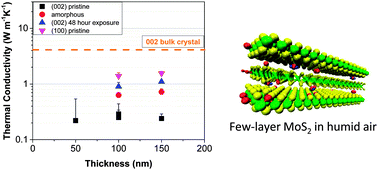Thermal anisotropy in nano-crystalline MoS2 thin films
Abstract
In this work, we grow thin MoS2 films (50–150 nm) uniformly over large areas (>1 cm2) with strong basal plane (002) or edge plane (100) orientations to characterize thermal anisotropy. Measurement results are correlated with molecular dynamics simulations of thermal transport for perfect and defective MoS2 crystals. The correlation between predicted (simulations) and measured (experimental) thermal conductivity are attributed to factors such as crystalline domain orientation and size, thereby demonstrating the importance of thermal boundary scattering in limiting thermal conductivity in nano-crystalline MoS2 thin films. Furthermore, we demonstrate that the cross-plane thermal conductivity of the films is strongly impacted by exposure to ambient humidity.


 Please wait while we load your content...
Please wait while we load your content...